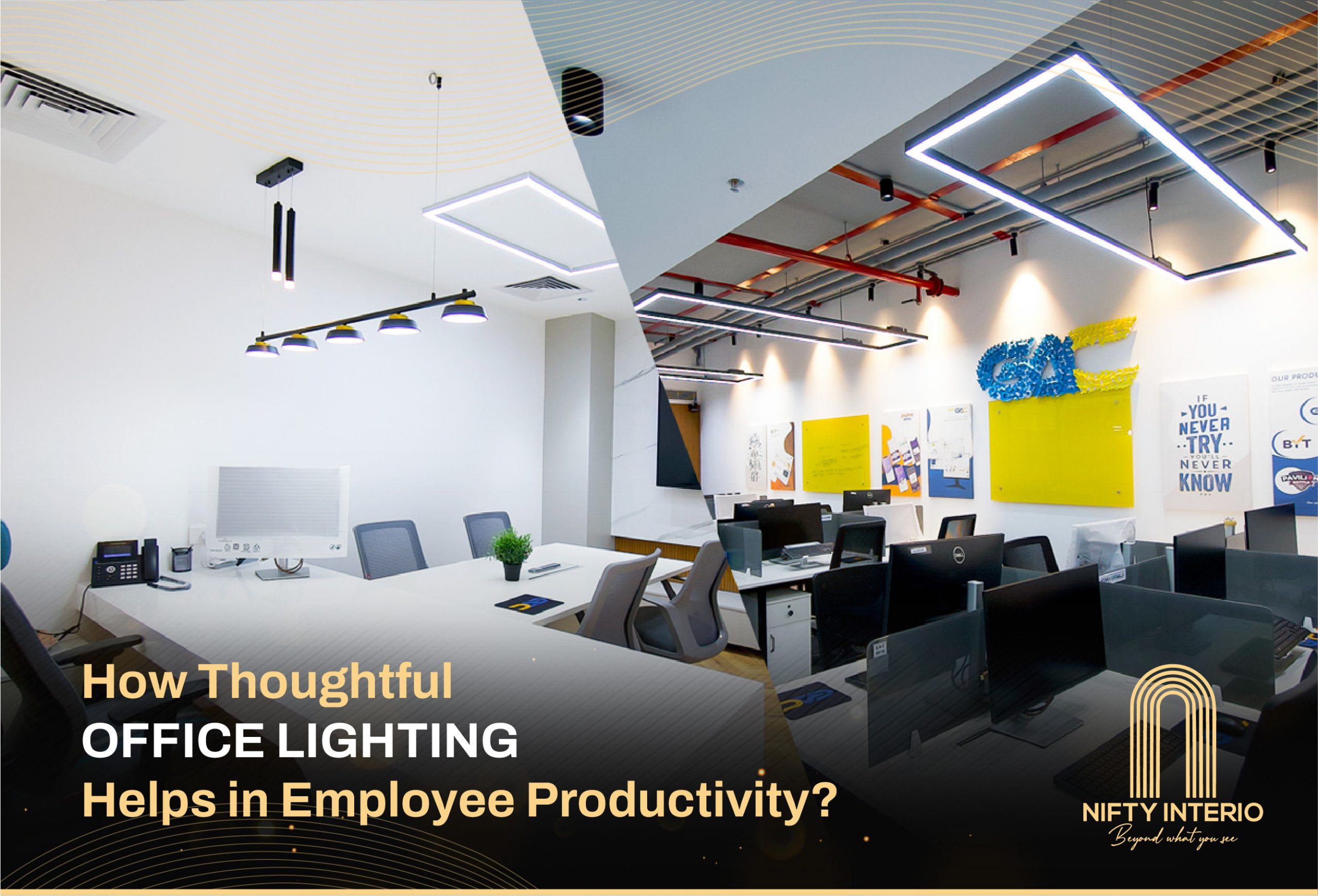Why the Right Office Lighting is Key to Boosting Employee Productivity?

Aug 14, 2023
In commercial interior design, every element holds immense importance in shaping the atmosphere and functionality of a workspace. Among these elements, office lighting stands out as a pivotal factor that significantly impacts the well-being and productivity of employees. Properly designed lighting can make a substantial difference in creating an optimal office environment that boosts overall satisfaction and performance.
Pause for a moment and observe your surroundings. Count the various sources of light that grace your environment. Is it the gentle embrace of natural light that bathes your space, or does artificial lighting dominate the scene? Notice how these lights shape your emotions and mood shift as your gaze traces the luminous contours around you?
Our lives are intricately linked with the surrounding light, processed through internal photoreceptors. Emerging research emphasises how factors like colour temperature, intensity, and quality of light impact our mood, creativity, and workplace productivity.
With that in mind, let’s explore the significance of adequate office lighting in commercial interior designs and how commercial interior designers in Hyderabad perfectly execute its undeniable impact on worker productivity.
The Role of Office Lighting in Commercial Interior Design
In India, a typical full-time employee dedicates approximately 3000 hours annually. This equates to more than a third of an entire year, during which office lighting influences attention span, daily rhythms, and emotional well-being. Effectively, a significant portion of one’s year is shaped by the nuances of office lighting design.
Interestingly, the evolution of office interior design has transcended mere aesthetics to encompass a holistic approach that prioritises efficiency, comfort, and creativity. Within this paradigm, lighting emerges as a fundamental cornerstone, playing a multifaceted role in shaping the office environment. From setting the tone and mood to aiding in tasks, lighting can transform an ordinary workspace into a thriving productivity nexus.
A professional commercial interior designer in Hyderabad plans and considers the different types of lighting needed for various office areas. Ambient lighting provides overall illumination, task lighting focuses on specific tasks, and accent lighting adds depth and dimension to the space. Balancing these types of lighting is essential to ensuring a harmonious blend that caters to the needs of employees while aligning with the organisation’s goals.
Must Read: 5 Commercial Interior Design Facts That Influence A Business’ Success
Explore the Spectrum: Light Temperature and Colours
Let’s demystify these terms for those who need to be better versed in the intricacies of lighting temperatures and colours.
The measurement of light temperature, denoted in Kelvin (K), quantifies the colours emitted when an object is heated. As the object’s temperature increases, its colour spectrum transforms from red tones to bluish-whites. Warm tones arise at lower temperatures, while cooler blues emerge at higher temperatures, encapsulating the core concept of lighting temperature.
- Here’s a breakdown of colour temperatures in light sources:
- Light sources with higher colour temperatures (4,600K or more) manifest a blue-white hue, commonly called cool or daylight colours.
- Mid-range colour temperatures (3,100K to 4,600K) project a cool white appearance.
- Lower colour temperatures (up to 3,000K) encompass tones ranging from red to yellowish-white, aptly named warm colours.
Understanding these complexities enables office interior design to curate workspaces that correspond with jobs, emotions, and ambience, enlivening spaces with carefully chosen lighting.
Unveil the Magic Gleam of Productivity
Effective office lighting design goes hand in hand with the principles of commercial interior design. It’s about creating a holistic environment that harmonises aesthetics and functionality. When planning your office lighting, consider the following factors:
Colour Temperature: The colour of light matters. Cooler light (higher colour temperature) is better suited for tasks requiring focus, while warmer light (lower colour temperature) can contribute to relaxation and social areas.
Flexibility: Implement lighting systems that can be adjusted based on the time of day and specific tasks. Dimmable lights and automated systems that mimic natural light changes can help regulate circadian rhythms.
Minimise Glare: Glare on screens and shiny surfaces can cause discomfort and reduce visibility. Opt for anti-glare coatings on screens and matte finishes on surfaces to mitigate this issue.
Energy Efficiency: Embrace energy-efficient LED lighting solutions that not only save costs but also have a positive impact on the environment.
Task Zones: Illuminate distinct work areas according to their functions. Direct lighting to enhance focus, diffuse lighting for communal spaces, and accent lighting to highlight architectural elements.
Biophilic Elements: Integrate elements like sunlight simulation and greenery. These nurture well-being, mirroring nature’s influence and invigorating your workspace.
Visual Comfort: Uniform and balanced lighting minimises eye strain and fatigue. Combine ambient, task, and accent lighting to craft an ergonomic and visually soothing environment.
Brand Expression: Leverage lighting to reflect your brand’s identity. Creative lighting aligns with your commercial interior design, crafting a memorable and authentic workspace.
Technology Integration: Smart lighting systems offer control and personalisation. Incorporate intuitive technology to empower occupants and adapt to their preferences.
Maintenance Ease: Opt for fixtures and layouts that simplify maintenance. Thoughtful choices decrease downtime, ensuring a consistently well-lit and productive space.
Intertwining lighting innovation with commercial interior design principles produces an office symphony where brilliance harmonises with purpose.
Conclusion
The area of office lighting emerges as a quiet but significant contributor in the pursuit of increased workplace efficiency. The artful integration of lighting in interior design by commercial interior designers in Hyderabad can transform a drab workspace into a core of inventiveness, attentiveness, and overall well-being. By grasping the intricate interplay connecting illumination and output and adopting intentional lighting approaches ingrained in office interior design, enterprises can encourage their staff to thrive and surpass themselves in their professional endeavours.
Thus, as you assess your commercial interior design and office arrangement, remember that a switch toggle could reveal the key to unleashing your team’s utmost productivity potential.

An ambitious entrepreneur & self-made designer revolutionizing interior aesthetics with innovative, functional, & personalized designs. Founder of Nifty Interio, creating designs that bring dreams to life.
